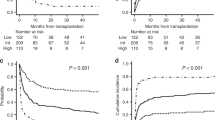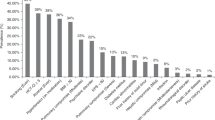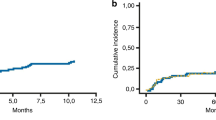Abstract
The O-PRISM score was introduced for risk assessment in children transferred to intensive care following BMT. The aim of this study is to determine the prognostic value of a serial evaluation of the O-PRISM score. Ninety-three children, 58 allogeneic-related and 35 unrelated BMT, were evaluated. At weekly intervals, the O-PRISM was calculated based on the standard PRISM score and the three additional variables CRP, GVHD and hemorrhage. Overall survival was 0.51 ± 0.05 (48/93 patients). Seventeen children died of recurrent disease and 28 of BMT-related complications. High O-PRISM scores significantly correlated with adverse outcome. The relative risks of DOC of patients with scores ⩾10 compared to patients with lower scores were: day 0: 3.9 (95% confidence-interval: 1.1–13.7, P = 0.02), day 7: 2.0 (0.7–6.2, P = 0.20), day 14: 5.2 (1.9–14.0, P = 0.001), day 21: 5.6 (1.9–16.5, P = 0.001), day 28: 11.5 (3.8–100.9, P < 0.001), day 35: 7.3 (1.9–27.7, P = 0.001). As early as day 0, children with scores ⩾10 points showed a higher cumulative incidence of DOC than patients with lower scores (0.69 ± 0.15 vs 0.27 ± 0.05, P = 0.02). The O-PRISM score represents a useful clinical parameter for serial risk assessment following BMT. As it indicates fatal events early, it may be helpful for parent information and even more for the early establishment of intensified supportive treatment. The O-PRISM score may therefore be a valuable parameter for the evaluation of different strategies for BMT and supportive treatment.
Bone Marrow Transplantation (2002) 29, 383–389. doi:10.1038/sj.bmt.1703384
This is a preview of subscription content, access via your institution
Access options
Subscribe to this journal
Receive 12 print issues and online access
$259.00 per year
only $21.58 per issue
Buy this article
- Purchase on Springer Link
- Instant access to full article PDF
Prices may be subject to local taxes which are calculated during checkout




Similar content being viewed by others
References
Giralt S, Estey E, Albitar M et al. Engraftment of allogeneic hematopoietic progenitor cells with purine analog-containing chemotherapy: harnessing graft-versus-leukemia without myeloablative therapy Blood 1997 89: 4531 4536
Slavin S, Nagler A, Naparstek E et al. Nonmyeloablative stem cell transplantation and cell therapy as an alternative to conventional bone marrow transplantation with lethal cytoreduction for the treatment of malignant and nonmalignant hematologic diseases Blood 1998 91: 756 763
Nichols DG, Walker LK, Wingard JR et al. Predictors of acute respiratory failure after bone marrow transplantation in children Crit Care Med 1994 22: 1485 1491
Torrecilla C, Cortes JL, Chamorro C et al. Prognostic assessment of the acute complications of bone marrow transplantation requiring intensive therapy Intensive Care Med 1988 14: 393 398
Schneider DT, Lemburg P, Sprock I et al. Introduction of the oncological pediatric risk of mortality score (O-PRISM) for ICU support following stem cell transplantation in children Bone Marrow Transplant 2000 25: 1079 1086
Bönig H, Schneider DT, Sprock I et al. ‘Sepsis’ and multi-organ failure: predictors of poor outcome after hematopoietic stem cell transplantation in children Bone Marrow Transplant 2000 25: (Suppl. 2) S32 S34
Afessa B, Tefferi A, Hoagland HC et al. Outcome of recipients of bone marrow transplants who require intensive-care unit support Mayo Clin Proc 1992 67: 117 122
Jackson SR, Tweeddale MG, Barnett MJ et al. Admission of bone marrow transplant recipients to the intensive care unit: outcome, survival and prognostic factors Bone Marrow Transplant 1998 21: 697 704
Hayes C, Lush RJ, Cornish JM et al. The outcome of children requiring admission to an intensive care unit following bone marrow transplantation Br J Haematol 1998 102: 666 670
Warwick AB, Mertens AC, Shu XO et al. Outcomes following mechanical ventilation in children undergoing bone marrow transplantation Bone Marrow Transplant 1998 22: 787 794
Hollmig KA, Soehngen D, Leschke M et al. Long-term survival of recipients of allogeneic bone-marrow transplantation after mechanical ventilation Eur J Med Res 1997 2: 62 66
van Veen A, Karstens A, van der Hoek AC et al. The prognosis of oncologic patients in the pediatric intensive care unit Intensive Care Med 1996 22: 237 241
Paz HL, Crilley P, Weinar M et al. Outcome of patients requiring medical ICU admission following bone marrow transplantation Chest 1993 104: 527 531
Rubenfeld GD, Crawford SW . Withdrawing life support from mechanically ventilated recipients of bone marrow transplants: a case for evidence-based guidelines Ann Intern Med 1996 125: 625 633
Diaz DH, Moreno A, Olive T et al. Role of the intensive care unit in children undergoing bone marrow transplantation with life-threatening complications Bone Marrow Transplant 1999 24: 163 168
Nichols DG, Walker LK, Wingard JR et al. Predictors of acute respiratory failure after bone marrow transplantation in children Crit Care Med 1994 22: 1485 1491
Price KJ, Thall PF, Kish SK et al. Prognostic indicators for blood and marrow transplant patients admitted to an intensive care unit Am J Respir Crit Care Med 1998 158: 876 884
Paz HL, Garland A, Weinar M et al. Effect of clinical outcomes data on intensive care unit utilization by bone marrow transplant patients Crit Care Med 1998 26: 66 70
Rossi R, Shemie SD, Calderwood S . Prognosis of pediatric bone marrow transplant recipients requiring mechanical ventilation Crit Care Med 1999 27: 1181 1186
Pollack MM, Patel KM, Ruttimann UE . The Pediatric Risk of Mortality III-Acute Physiology Score (PRISM III-APS): a method of assessing physiologic instability for pediatric intensive care unit patients J Pediatr 1997 131: 575 581
Pollack MM, Ruttimann UE, Getson PR . Pediatric risk of mortality (PRISM) score Crit Care Med 1988 16: 1110 1116
Nürnberger W, Willers R, Burdach S et al. Risk factors for capillary leakage syndrome after bone marrow transplantation Ann Hematol 1997 74: 221 224
Burdach S, van Kaick B, Laws HJ et al. Allogeneic and autologous stem-cell transplantation in advanced Ewing tumors. An update after long-term follow-up from two centers of the European Intergroup study EICESS. Stem-Cell Transplant Programs at Düsseldorf University Medical Center, Germany and St. Anna Kinderspital, Vienna, Austria Ann Oncol 2000 11: 1451 1462
Hill GR, Cooke KR, Brinson YS et al. Pretransplant chemotherapy reduces inflammatory cytokine production and acute graft-versus-host disease after allogeneic bone marrow transplantation Transplantation 1999 67: 1478 1480
Middleton PG, Taylor PR, Jackson G et al. Cytokine gene polymorphisms associating with severe acute graft-versus-host disease in HLA-identical sibling transplants Blood 1998 92: 3943 3948
Marcin JP, Pollack MM, Patel KM et al. Decision support issues using a physiology based score Intensive Care Med 1998 24: 1299 1304
Salat C, Holler E, Kolb HJ et al. Endothelial cell markers in bone marrow transplant recipients with and without acute graft-versus-host disease Bone Marrow Transplant 1997 19: 909 914
Salat C, Holler E, Schleuning M et al. Levels of the terminal complement complex, C3a-desArg and C1-inhibitor in adult patients with capillary leak syndrome following bone marrow transplantation Ann Hematol 1995 71: 271 274
Acknowledgements
The authors gratefully acknowledge the generous support by Elterninitiative Kinderkrebsklinik e. V. Düsseldorf. The authors wish to thank Monika Schmitz for her assistance with data collection and the nurses of the BMT unit for their expert care of the children. This work is dedicated to Professor Dr P Lemburg, director emeritus of the Pediatric Intensive Care Unit, in acknowledgment for his invaluable support and his long-standing dedication to the most compromised children treated at our institution.
Author information
Authors and Affiliations
Rights and permissions
About this article
Cite this article
Schneider, D., Cho, J., Laws, H. et al. Serial evaluation of the oncological pediatric risk of mortality (O-PRISM) score following allogeneic bone marrow transplantation in children. Bone Marrow Transplant 29, 383–389 (2002). https://doi.org/10.1038/sj.bmt.1703384
Received:
Accepted:
Published:
Issue Date:
DOI: https://doi.org/10.1038/sj.bmt.1703384
Keywords
This article is cited by
-
The critically-ill pediatric hemato-oncology patient: epidemiology, management, and strategy of transfer to the pediatric intensive care unit
Annals of Intensive Care (2012)
-
Vitamin K deficiency in children pre-bone marrow transplantation
Bone Marrow Transplantation (2006)



